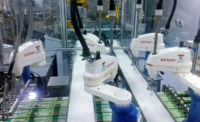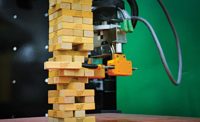CAMBRIDGE, MA—Massachusetts Institute of Technology (MIT) researchers have developed the RoboGrammar system, which automatically generates an optimal structure and controller for an arthropod-inspired robot to traverse a given terrain. The system generates this outcome based on a set of user-specified primitive components, according to the research paper, “RoboGrammar: Graph Grammar for Terrain-Optimized Robot Design.”
The process starts with the user defining the problem and inputting specified primitive components (such as joint types, links and wheels), each with prescribed attributes (such as rotational angles and axes, sizes and weights). The user also specifies the variety of terrain to be traversed, which can include combinations of elements like steps, flat areas, or slippery surfaces. This step is key to making sure the robot can be built in the real world.
According to the paper, each robot is represented by a graph. The researchers use a set of production rules and valid graphs (graph grammar) that allow complex 3D modelling. They openly credit ideas from earlier examples, such as graph grammars for epicyclic gear train systems and for modeling self-assembly of robotic systems, as inspiration for their method, which offers the benefits of scalability and applicability.
The grammar rules are complemented by physical and controller synthesis, which allowed the researchers to optimize and test robot designs. An algorithm called model predictive control (MPC) was used to rapidly find a stable, periodic gait and which prioritized rapid forward movement.
Allan Zhao, the paper’s lead author and a PhD student in the MIT Computer Science and Artificial Intelligence Laboratory (CSAIL), says the shape and the controller of the robot are intertwined. He drew inspiration from arthropods—insects, spiders and lobsters--and adopted their movements for robot flexibility, but added mechanical parameters, such as wheels as an alternative to legs.
“We have to optimize a controller for every given robot individually,” he says. “They are characterized by having a central body with a variable number of segments. Some segments may have legs attached. And we noticed that that’s enough to describe not only arthropods but more familiar forms as well,” including quadrupeds."
Once each simulated robot is free to move about, the researchers can seek out high-performing robots with a “graph heuristic search.” This neural network algorithm iteratively samples and evaluates sets of robots, and it learns which designs tend to work better for a given task. “The heuristic function improves over time,” explains Zhao, “and the search converges to the optimal robot.”
The research team plans to build and test some of RoboGrammar’s optimal robots in the real world. Zhao believes one example would be to help populate virtual worlds. “Let’s say in a video game you wanted to generate lots of kinds of robots, without an artist having to create each one,” he concludes.


